In 2022, February 4, one of the most famous abandoned cities turned 52. This city was once a model city of the Soviet government and was established for the workers of the nuclear power plant and their families.
Pripyat – the ghost town of the Chernobyl Exclusion Zone, was once full of life with all the luxuries of a modern city – a railway station, port, hospital and even a fairground, until the fateful day of 26 of April, 1986.
So, are you ready to delve deeper into the biography of Pripyat city and pull back the curtain on: How was the 9th atomic city of the Soviet Union born? What was life like in Pripyat, the city of nuclear scientists?
Nuclear Energy In The Soviet Union: Soviet Atomic Program
Attempts to use a controlled nuclear reaction to generate electricity in the USSR began in the 1940s. Soviet physicists paid close attention to the news of the discovery of fission in Germany in 1938. Throughout 1939, leading Soviet physicists attempted to reproduce the fission experiment that Otto Hahn and Fritz Strassmann had conducted in Berlin and began to make measurements and calculations to determine under exactly what conditions, if any, a nuclear chain reaction would take place.
After Germany invaded the Soviet Union in 1941, Soviet nuclear physics work largely ceased. Scientists and engineers were drafted or assigned to work on projects, such as radar, that were seen as much more pressing. Soviet leaders learned that both the United States and Germany had embarked on efforts to build an atomic bomb. In February 1943, the Soviets began their own program led by nuclear physicist, Igor Kurchatov, and political director Lavrentiy Beria.
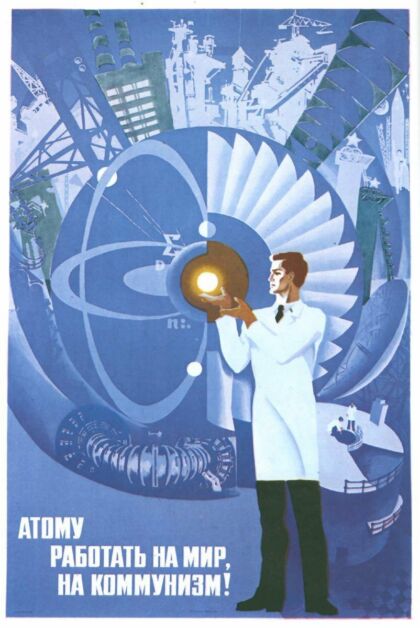 Soviet poster about nuclear energy
Soviet poster about nuclear energyTranslation: Atom works for peace, for communism!
In Autumn 1945, a group of physicists led by Kurchatov presented a report to the country’s leadership where it was mentioned that, in addition to weapons, nuclear energy can be used – in nuclear power plants, transport, industry, and agriculture.
To which then the head of the Soviet Union, Stalin, said briefly: “First make a bomb, and then everything else!”
 Mushroom cloud of the ground explosion of the first Soviet atomic bomb at the Semipalatinsk test site. August 29, 1949.
Mushroom cloud of the ground explosion of the first Soviet atomic bomb at the Semipalatinsk test site. August 29, 1949.The first atomic bomb was successfully tested in the USSR in 1949. The following year, Stalin personally signed the decree of the Council of Ministers of the USSR “On research, design and experimental work on the use of atomic energy for peaceful purposes.” In 1954, the Obninsk nuclear power plant, the first in the USSR and in the world, was put into operation in the Kaluga Region.
In the 1960s, industry and urban construction boomed in the Soviet Union. The thermal and hydroelectric power plants built at that time could not fully provide plants, factories and the population with electricity. In 1966, by a decree of the Council of Ministers of the USSR, a plan was approved for the construction and commissioning of nuclear power plants throughout the country, including in Ukraine.
This type of power plant was much less expensive than the existing ones, although they all bear certain costs and danger to people and the natural environment.
According to this resolution, it was planned to build a nuclear power plant in the southern part of the Unified Energy System of the USSR, which should provide electricity to the Central Energy Region – the entire territory of the Ukrainian SSR and the Rostov Region.
Why Chernobyl?
 Design plans for the Chernobyl Main District Power Plant, which would later be known as Chernobyl Nuclear Power Plant.
Design plans for the Chernobyl Main District Power Plant, which would later be known as Chernobyl Nuclear Power Plant.In 1965-1966, 16 construction sites for a future nuclear power plant were considered in three regions of Ukraine – Vinnytsa, Zhytomyr, and Kyiv. It was settled on two options – near the village of Ladyzhin, in the Gaisinsky district, – of the Vinnitsa region, on the right bank of the Southern Bug river, and near the village of Kopachi, in the Chernobyl district, – of the Kyiv region, on the right bank of the Pripyat River, 15 kilometers from the city of Chernobyl.
In 1967, the second option was approved, namely the area of the Yanov railway station (South-Western Railway), to which it would be cost-effective to deliver building material for the Chernobyl Nuclear Power Plant.
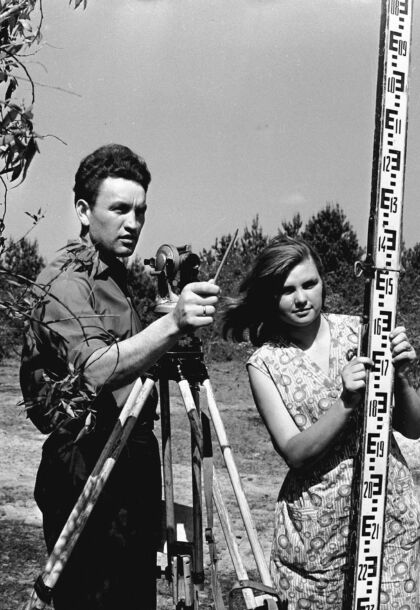 Surveyors Vladimir Slobodenyuk and Lyubov Rodenyuk are marking the main construction sites of the future Chernobyl nuclear power plant, May 25, 1971.
Surveyors Vladimir Slobodenyuk and Lyubov Rodenyuk are marking the main construction sites of the future Chernobyl nuclear power plant, May 25, 1971.Photo: Unknown
The Pripyat River was also convenient for filling and replenishing the cooling pond with water, the lands were not fertile enough, and their transfer for the construction of a city and a nuclear power plant would not bring great economic losses to the existing collective farms.
In January 1970, the directorate of the Chernobyl Nuclear Power Plant was created, headed by Viktor Bryukhanov. He led the construction and operation of the station until the accident in April 1986.
 Laying the first cubic meters of concrete in the foundation of the Chernobyl Nuclear Power Plant, August 15, 1972 .
Laying the first cubic meters of concrete in the foundation of the Chernobyl Nuclear Power Plant, August 15, 1972 .Photo: Unknown
In May 1970, a foundation pit was laid out for the first power unit of the Chernobyl Nuclear Power Plant. In August 1972, the first cubic meter of concrete was solemnly poured into the base of the main building of the first stage of the station and a stainless capsule with a letter to future generations was laid.
Initially, the launch of the first power unit of the Chernobyl NPP was scheduled for 1974. But already at the first stages of construction, this period was in risk. The fact is that the general contractor, the “Kremenchuggestroy” trust, had never built nuclear power plants before.
By April 1972, the Central Committee of the Communist Party of Ukraine and the Council of Ministers of the Ukrainian SSR had already complained “that the construction department” Kremenchuggestroy”of the Ministry of Energy and Electrification of the USSR was developing construction too slowly.
The Ninth “Atomgrad”
 Pripyat city – view of Post office, Educational institution and Amusement Park.
Pripyat city – view of Post office, Educational institution and Amusement Park.Photo: Local History Museum of Slavutych
During the Cold War, the Soviet Union developed more than 10 “Atomgrads“ – small industrial cities (from 30,000 to 80,000 inhabitants) designed to serve the needs of large nuclear power plants. Such cities were newly designed and built to provide housing and community services for the future scientists and their families that would live there.
With few exceptions, they were all situated amidst agrarian land- and riverscapes, which Soviet engineers and planners regarded as appropriate for the construction of nuclear power plants. The sites were not too far from industrial regions in need of electric energy, but sparsely populated. They were easily integrated into existing railway and high voltage grids, and well supplied with cooling water and plenty of “empty” space for large industrial and urban constructions. One of those cities was Pripyat.
Founded by the Soviet Union as the 9th Atomgrad, Pripyat was once a model city of the Soviet government and was established in 1970 (4th February) for the workers of the nuclear power plant and their families.
Before that, the following Atomgrads were built:
- Obninsk (Obninsk NPP)
- Sosnovy Bor (Leningrad NPP)
- Kurchatov (Kursk NPP)
- Udomlya (Kalinin NPP),
- Novovoronezh (Novovoronezh NPP).
Interesting fact: the Chernobyl Nuclear Power Plant has two satellite cities, because after the closure of Pripyat and the emergency power unit, the station worked for another 4 years. The city of Slavutych was built for workers and their families, which is still alive and well. The population of the city is about 25 thousand people.
How Pripyat was built
 The map of the prospective development of the city was restored from photographs taken by the first head of the “Chernobyl” Zone, Vasily Ivanovich Gorokhov, in the premises of the Pripyat Department of Housing and Communal Services in 1986. The map shows the prospects for the development of Pripyat in the XII-XIII five-year plans, taking into account the commissioning of the 5th and 6th power units of the Chernobyl NPP and the development of the “sandy plateau”, which was to house the VI microdistrict of the city.
The map of the prospective development of the city was restored from photographs taken by the first head of the “Chernobyl” Zone, Vasily Ivanovich Gorokhov, in the premises of the Pripyat Department of Housing and Communal Services in 1986. The map shows the prospects for the development of Pripyat in the XII-XIII five-year plans, taking into account the commissioning of the 5th and 6th power units of the Chernobyl NPP and the development of the “sandy plateau”, which was to house the VI microdistrict of the city.Source: pripyat-city.ru
Six sites were proposed to accommodate the village of Pripyat – in the area of the city of Chernobyl, north and south of the village of Kopachi, west of the Yanov station, on the site of the future village of Lesnoy, etc. Comparing all the pros and cons, a site was chosen southwest of the village of Semykhody.
The very first builders and surveyors in 1969-1970 lived on two barges that were moored to the banks of the Pripyat River near the Yanov farm, later renamed the village. Podlesnoye. Cabins were made on the deck of the barges for the pioneers to live.
In February 1970, three kilometers from the Chernobyl Nuclear Power Plant, they began to build a working settlement – the future city of nuclear scientists Pripyat. According to the 1969 project, it was designed for 75-85 thousand people. In the meantime, the staff and builders lived in dormitories or in villages around the station under construction.
«We lived in dormitories, first together with the builders, and then in a separate, stationary one. Family rented apartments within a radius of 20 kilometers from the station. All the villages were populated by exploiters and builders. We lived together with the owners, and who was lucky – separately», — recalled one of the participants in the construction and the future head of the chemical department of the Chernobyl NPP, Evgeny Yashin.
 Semykhody village
Semykhody villagePhoto: Local History Museum of Slavutych
Source: pripyat-city.ru
February 4, 1970 is considered the beginning of the construction of the city of Pripyat. The first peg was scored by the chief geodesist of “Yuzhatomstroy, ” G. Popovich on the Bondarenkov field near the Semykhody village. Collective farmers sowed grain crops on this field, near it grew a young pine forest planted in 1946.
 Construction of buildings on the central square of the city, on Kurchatov street.
Construction of buildings on the central square of the city, on Kurchatov street.Photo: Local History Museum of Slavutych
Source: pripyat-city.ru
The first working drawings of the binding were issued for dormitories numbered from 1 to 4 and houses No. 3 and No. 5 on the Druzhby Narodiv street. The construction of hostel No. 1, the building of the construction department, canteen No. 1, and the Lesnoy settlement for the first builders began, which was located just south of the Yanov station.
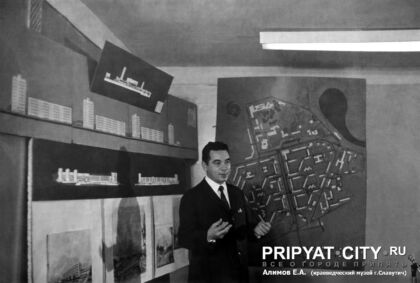 Chief architect of Pripyat Gennady Ivanovich Oleshko. In 1985, he was awarded the Prize of the Council of Ministers of the USSR for the development of the city, posthumously.
Chief architect of Pripyat Gennady Ivanovich Oleshko. In 1985, he was awarded the Prize of the Council of Ministers of the USSR for the development of the city, posthumously.Photo: Local History Museum of Slavutych
Source: pripyat-city.ru
There were no problems with the timing of the construction of the satellite city of the nuclear station. It was built even faster than the Chernobyl NPP itself, because about six thousand builders had to be placed and fed somewhere. Therefore, the first buildings in the city in 1971 were dormitories and canteens.
 The original architect’s drawings of Pripyat’s planning, 1968.
The original architect’s drawings of Pripyat’s planning, 1968.For other Soviet nuclear power plants, such satellite cities were usually rebuilt several months or even years before the start of construction of the nuclear plant itself. The first apartment buildings in Pripyat had already been built in 1972, at the same time the new settlement received the status of an urban-type settlement, and in 1979 – the status of a city.
First of all, Pripyat was built for the employees of the Chernobyl Nuclear Power Plant. But very quickly the city became one of the main transport hubs of Polissya. Nearby, the Yanov railway station already existed, and during the construction process, the fairway of the Pripyat River was extended – now there was a navigable route with a length of almost 600 kilometers nearby. Several highways were also built around the city.
Structure Of Pripyat City: The Principle Of “Triangular” Construction
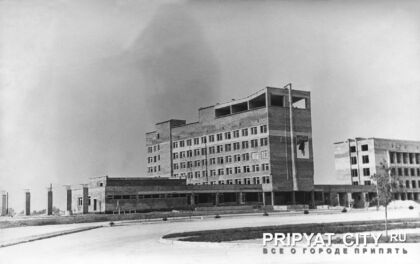 Construction of the complex of the city executive committee, the hotel “Polissya” with a restaurant and a colonnade.
Construction of the complex of the city executive committee, the hotel “Polissya” with a restaurant and a colonnade.Photo: Local History Museum of Slavutych
Source: pripyat-city.ru
Pripyat – consisted of 5 micro districts and had a clearly visible center. By tradition, administrative buildings (city council), leisure, cultural and recreational facilities (the Prometheus cinema, a park, the Palace of Culture “ Energetik”, the Polissya hotel), department stores, and a hotel complex were all located in the city center.
And although there are 19 more palaces of culture and 11 cinemas in the expanses of the former Soviet Union, built according to the same project as the Palace of Culture “ Energetik” and the Prometheus cinema, Pripyat was a standard of building uniqueness and Soviet architectural delights.
 Perspective development project of Pripyat
Perspective development project of PripyatPhoto: Local History Museum of Slavutych
Source: pripyat-city.ru
The main town-planning idea of Pripyat was the principle of “triangular” construction, developed by a group of Moscow architects led by Nikolai Ostozhenko.
For that time, this form of building was unique. However, simultaneously with the development of Pripyat, the same scheme was used in the construction of a dozen other cities in the Soviet Union. In particular, individual micro-districts of Pripyat are one hundred percent similar to the residential areas of other atomic cities – Kurchatov and Semipalatinsk-21, Volgodonsk – and the Togliatti auto city.
 Construction of a supermarket on the main square of the city. View on Polissya Hotel and the Palace of Culture “ Energetik”.
Construction of a supermarket on the main square of the city. View on Polissya Hotel and the Palace of Culture “ Energetik”.Photo: Local History Museum of Slavutych
Source: pripyat-city.ru
The principle of “triangular” construction is characterized by a mixture of standard-rise residential buildings and high-rise buildings. A feature of such construction is the visual space and free spaces between buildings. Unlike old cities with narrow streets and dense buildings, Pripyat was designed to provide comfortable living. In addition to a conscious increase in free urban space, this goal was also achieved by the equal-angle arrangement of streets and avenues, excluding the appearance of traffic jams.
The first buildings of Pripyat
 Construction of the 1st and 2nd microdistricts of the city, Lenin Prospekt, 1972.
Construction of the 1st and 2nd microdistricts of the city, Lenin Prospekt, 1972.Photo: Local History Museum of Slavutych
The first buildings in Pripyat that were based on the main needs of the then population, were to build hostel No. 1, canteen No. 1, and the construction management building. The first street on which the buildings were located was Druzhby Narodiv Street.
By August 1971, the city had already acquired the features of a settlement. Problems with drinking water and sewerage were solved, the first house with 90 apartments is completely ready for operation. A year later, in 1972, the first school was built in Pripyat.
April 14, 1972 can be considered the real birthday of the city. On this day, the Presidium of the Supreme Council of the Ukrainian SSR assigned the name of the builders’ settlement to the then – Pripyat, in honor of the river near which it was located. The status of the city of the settlement was given only in 1979.
 View on Lenin Avenue, city center of Pripyat
View on Lenin Avenue, city center of PripyatPhoto: Local History Museum of Slavutych
Not only did the new settlers fall in love with the new city, but also officials – tourists and official delegations from all over the world were brought here to show how the modern Soviet people live. They showed Lenin Avenue, Druzhby Narodiv street and Heroes of Stalingrad street, Naberezhna Street, avenues of Builders and Enthusiasts.
 The Palace of Culture “Energetik” before and after the Chernobyl disaster.
The Palace of Culture “Energetik” before and after the Chernobyl disaster.Photo: Local History Museum of Slavutych and ChernobylX
In 1984, the Palace of Culture “Energetik” with an area of about 17 thousand square meters was put into operation. Many labor, cultural, and entertainment competitions were held here. City events were held at a high level.
 View of the main square of Pripyat city from the roof of the Shopping Center, 1983.
View of the main square of Pripyat city from the roof of the Shopping Center, 1983.Photo: Local History Museum of Slavutych
Source: pripyat-city.ru
The names of the streets of Lesya Ukrainka and Kurchatov caused particular pride among the residents of Pripyat. In the center of the city, – on a large square, there were the buildings of the city council, the Prometheus cinema, the Palace of Culture “Energetik”, the Polissya hotel, shops and cafes, all next to the City Park of Culture and Recreation.
And by the end of 1988 was planned to finish:
- two more large shopping centers
- a palace of pioneers
- a two-screen cinema
- the Yubileiny Palace of Arts
- two sports complexes
- the Oktyabr Hotel
- even their own television tower 52 meters high
Pripyat in Numbers
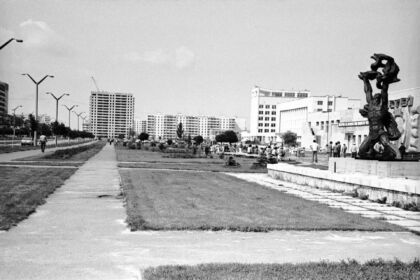 View of the main square of Pripyat with Prometheus cinema, Polissya Hotel and Executive Committee of the City Soviet of People’s Deputies, July 1980.
View of the main square of Pripyat with Prometheus cinema, Polissya Hotel and Executive Committee of the City Soviet of People’s Deputies, July 1980.Photo: Local History Museum of Slavutych
By the beginning of 1986, Pripyat was a city with a developed infrastructure. Pripyat was a young city, not because of its age, but because of the residents. There lived young people aged 23-28 years old with their families (there were kids in almost every family). The city had all the luxuries of a modern city – a railway station, port, hospital and even a fairground.
- The population of the city of Pripyat before the accident at the Chernobyl Nuclear Power Plant on April 26, 1986 was 49,400 people, including women – 16,562, and children – 15,406.
- Representatives of about 30 nationalities lived in the city.
- The total area of the housing stock is 658,700 m²: 160 houses, 13,414 apartments, 18 hostels for bachelors with 7621 places, eight family hostels and hotel-type houses with 1206 rooms.
- Children’s preschool institutions – 15 units for 4980 places.
- Educational institutions: secondary general education schools – 5 per 6,786 student places, vocational schools – one per 600 students.
- Medicine: medical unit (No. 126) for 410 beds, 1750 visits in three polyclinics.
- Retail: 25 shops with 9,239 m² of retail space.
- Public catering: 27 canteens, cafes, restaurants for 5535 seats.
- Culture: Palace of Culture, cinema with 1220 seats, Children’s Art School with eight rooms for group work, with a total capacity of 312 students.
- Sports: 10 sports halls, three swimming pools, 10 shooting ranges, two stadiums.
- Landscaping: park, 35 playgrounds and towns, 18,136 trees, 249,247 shrubs, more than 33,000 rose bushes.
- The annual population growth is more than 1,500 people, among which were about 800 are newborn Pripyat residents, and approximately 500-600 people have arrived for permanent residence from different parts of the Soviet Union.
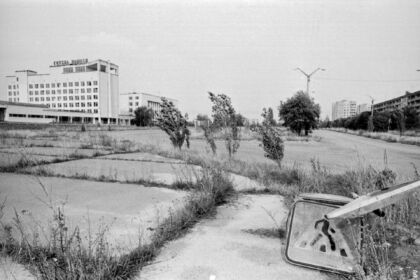 One of the streets of Pripyat after the accident at the Chernobyl Nuclear Power Plant, in the background the Polissya hotel, 1987-1989.
One of the streets of Pripyat after the accident at the Chernobyl Nuclear Power Plant, in the background the Polissya hotel, 1987-1989.Photo: Local History Museum of Slavutych
52 years old -, Pripyat is now a city of ghosts and despite no-one living there, it has its own grace and atmosphere. Pripyat did not meet its end like some nearby villages, which were buried underground by bulldozers. Boards on the road with their names and a village map commemorate the abandoned villages.
After the accident, Pripyat became one of the favorite places for stalkers, urban explorers, scientists, fans of extreme tourism from all over the world and journalists – to capture and feel the post-apocalyptic emptiness and silence that has been living there for more than thirty five years.
If you’re eager about Pripyat ghost town, you can already arrange your visit to the Chernobyl Exclusion Zone today and see it all with your own eyes.
SEE, FEEL, EXPERIENCE… BUT DO NOT TOUCH.
Radioactively yours, ChernobylX



 ChernobylX
ChernobylX
 ChernobylX
ChernobylX